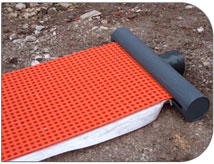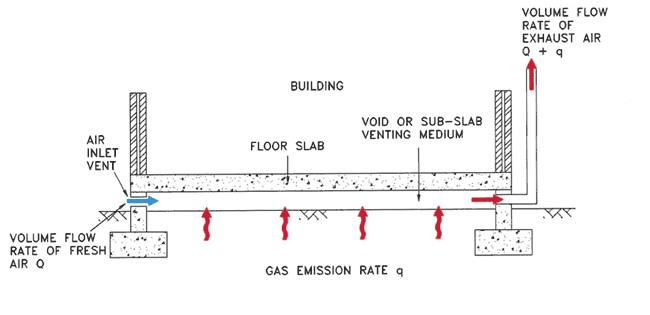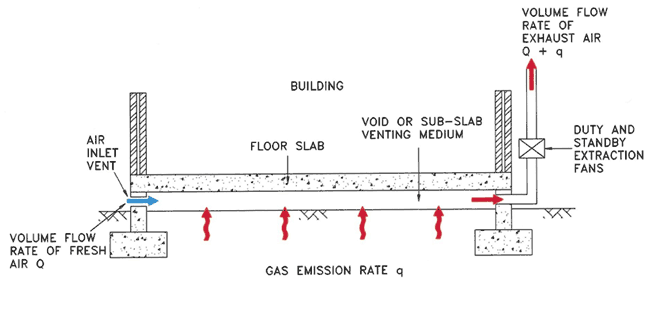Sub-slab Ventilation of Methane CO2 & Hydrocarbons
Current guidance (CIRIA Reports & Partners in Technology), has emphasised the importance of Sub-Slab Ventilation, whether it be an active system that is required, or a completely passive system to ensure the controlled and safe removal of ground gases beneath the building.
| Venting Layer | Vent Types |  |
|
|
Ventilation (Dilute & Disperse)
Purpose: to allow removal and dilution of gases from beneath buildings by the provision of an underslab venting layer. Passive Venting: relies on natural venting due to climatic conditions (predominantly wind). Active Venting: mechanical extraction to safely extract the gases beneath the building and vent to the atmosphere.
Principle of Venting Beneath Buildings
Passive Venting
Passive venting relies on natural venting due to climatic conditions, (predominantly wind). Below is an example of Passive Venting.

Active Venting
Active Venting: mechanical extraction to safely extract the gases beneath the building and vent to the atmosphere. Below is an example of Active Venting.

ACS SUB-SLAB DEPRESSURISATION SYSTEM
The ACS S-S D S system is a hybrid of the industry standard method of venting sub-slab gases to atmosphere, as recommended in CIRIA 149 gases should be extracted and vented to atmosphere.
ACS S-S D S has been developed to protect developments constructed on gas contaminated land. The system comprises of a number of depressurisation diffusers located beneath the building floor slab and linked into a depressurisation unit comprising a flameproof fan mounted within the extract pipe-work.
The fan is designed to be permanently running and ensures that a slight vacuum or negative pressure is created beneath the slab. This removes any ground gases moving upwards towards the slab and allows them to be safely vented to atmosphere.
Advantages:
- Ease of installation
- Installation as building work progresses or laid with mass poured floor slabs
- Remote Audible and Visual alarms at your choice of location
- Telemetric alarms installed via BT landline
- Works well with conventional barriers and void formers
- Full Professional Indemnity Insurance
- Low Cost Fixed Price maintenance
- No Perimeter installation work
The system is designed to vent all gases at sub-slab level, once installed it is connected to low power permanently running depressurisation units requiring low cost fixed price annual maintenance. The system is checked using our unique portable gas monitoring equipment. Remote audible alarms are installed at your choice of location.
A telemetric alarm can also be installed if required utilising a BT landline.